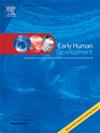出生后早期过渡循环限制了新生儿的生长。
IF 2
3区 医学
Q2 OBSTETRICS & GYNECOLOGY
引用次数: 0
摘要
背景:胎儿生长受限(FGR)可能影响产后早期过渡循环。目的:FGR新生儿出生后3天左室心输出量、上腔静脉(SVC)和静脉导管(DV)血流的超声心动图评价。研究设计:前瞻性观察性研究。研究对象:FGR和非FGR新生儿。结果指标:左心室心输出量、SVC和DV血流量第1、2和3天。结果:调整胎龄(GA)、出生体重、性别和双/单胎后,晚期fgr (GA≥32周,n = 23)和非fgr (GA≥32周,n = 39)之间的流量测量相似。在第三天,fgr晚期患者左室卒中容量显著降低(估计边际均值(标准误差)0.99 (0.08)vs 1.22 (0.06) mL/kg, p = 0.027),心率升高(134 (5)vs 119(4)次/分钟,p = 0.032)。两组左心室心输出量和左心室卒中容积从第1天到第3天显著下降;晚期fgr为170 (8)~ 149 (8)mL/min/kg, p = 0.007, 1.34 (0.07) ~ 1.17 (0.07) mL/kg, p = 0.015,非fgr为161 (6)~ 144 (6)mL/min/kg, p = 0.002, 1.27 (0.06) ~ 1.16 (0.06) mL/kg, p = 0.021。晚期fgr的SVC流量从第1天到第3天保持不变(92(6)至83 (6)mL/min/kg, p = 0.161),非fgr的SVC流量显著下降(83(5)至71 (5)mL/min/kg, p = 0.021)。DV血流量保持不变。早期fgr (GA 30+0-31+6周)和晚期fgr之间没有测量差异。结论:晚期fgr对新生儿早期左室心输出量、SVC和DV血流量影响有限。大多数适应性循环变化发生在过渡早期。本文章由计算机程序翻译,如有差异,请以英文原文为准。
Early postnatal transitional circulation in fetal growth restricted neonates
Background
Fetal growth restriction (FGR) may impact early postnatal transitional circulation.
Aim
Echocardiographic assessment of left ventricular cardiac output, superior vena cava (SVC) and ductus venosus (DV) blood flow in FGR neonates first three days after birth.
Study design
Prospective observational study.
Subjects
FGR and Non-FGR neonates.
Outcome measures
Left ventricular cardiac output, SVC and DV blood flow day one, two, and three.
Results
Adjusting for gestational age (GA), birth weight, sex, and twin/singleton, flow measurements were similar between Late-FGR (GA ≥ 32 weeks, n = 23) and Non-FGR (GA ≥ 32 weeks, n = 39). On day three, Late-FGR had significantly lower left ventricular stroke volume (Estimated Marginal Means (Standard Error) 0.99 (0.08) vs 1.22 (0.06) mL/kg, p = 0.027) and higher heart rate (134 (5) vs 119 (4) beats/min, p = 0.032). Left ventricular cardiac output and left ventricular stroke volume decreased significantly from day one to three in both groups; Late-FGR 170 (8) to 149 (8) mL/min/kg, p = 0.007, and 1.34 (0.07) to 1.17 (0.07) mL/kg, p = 0.015, and Non-FGR 161 (6) to 144 (6) mL/min/kg, p = 0.002, and 1.27 (0.06) to 1.16 (0.06) mL/kg, p = 0.021. SVC flow remained unchanged from day one to three in Late-FGR (92 (6) to 83 (6) mL/min/kg, p = 0.161) and decreased significantly in Non-FGR (83 (5) to 71 (5) mL/min/kg, p = 0.021). DV blood flow remained unchanged. No measurements differed between Early-FGR (GA 30+0–31+6 weeks) and Late-FGR.
Conclusions
Late-FGR had limited impact on left ventricular cardiac output, SVC and DV blood flow in early neonatal period. Most adaptive circulatory changes occurred early during transition.
求助全文
通过发布文献求助,成功后即可免费获取论文全文。
去求助
来源期刊

Early human development
医学-妇产科学
CiteScore
4.40
自引率
4.00%
发文量
100
审稿时长
46 days
期刊介绍:
Established as an authoritative, highly cited voice on early human development, Early Human Development provides a unique opportunity for researchers and clinicians to bridge the communication gap between disciplines. Creating a forum for the productive exchange of ideas concerning early human growth and development, the journal publishes original research and clinical papers with particular emphasis on the continuum between fetal life and the perinatal period; aspects of postnatal growth influenced by early events; and the safeguarding of the quality of human survival.
The first comprehensive and interdisciplinary journal in this area of growing importance, Early Human Development offers pertinent contributions to the following subject areas:
Fetology; perinatology; pediatrics; growth and development; obstetrics; reproduction and fertility; epidemiology; behavioural sciences; nutrition and metabolism; teratology; neurology; brain biology; developmental psychology and screening.
 求助内容:
求助内容: 应助结果提醒方式:
应助结果提醒方式:


